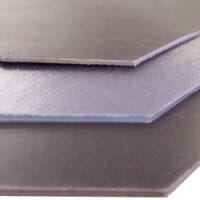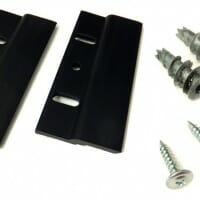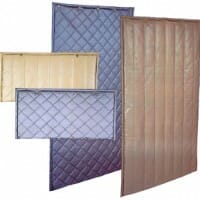Soundproofing A Room Without Damaging Walls
Life can get a little noisy, but we’re not always prepared for it. If you’re building a recording studio or live music club, you know what you’re in for ahead of time. You can construct your walls to handle the noise. But what if your kid gets a guitar or drum kit for his or her birthday? How about new neighbors that stay up late listening to loud music? There are so many situations that can have us asking, can you soundproof existing walls, that it’s definitely worth discussing.
Luckily, there are very effective means of soundproofing without damaging walls that can provide you with sound solutions that you may even be able to install on your own. If you’re thinking of soundproofing existing walls or ceilings, you’ll have to decide how much sound control you’re after, as well as how big a project you want to get into.
Simple Solutions for Soundproofing Without Damaging Walls
If the unwanted noise you’re experiencing isn’t too loud, but loud enough to keep you awake at night or are enough to constitute a source of constant annoyance, you can probably get by with some real simple solutions to soundproofing without damaging walls. Here’s how to soundproof an existing wall using nondestructive methods.
Soundproof Curtains
When your main gripe involves something that isn’t crazy loud, soundproof curtains are a very versatile option. Let’s say you have a busy street outside the room, or a dog that regularly barks a few doors down. You can cover your windows and walls with soundproof curtains to provide soundproofing measures that don’t necessarily require you to do any work with the walls. You can simply hang them from free standing rods, and those dense curtains will absorb a good deal of mid frequency sounds before they ever reach your ears. Coupling this approach with soundproof blankets can help reduce the undesired sound waves without having to touch walls and ceilings.
Window Inserts
Another great solution to sounds that seep in from the outdoors is window inserts. If you’re hearing noise from the outside, often your issue is the windows, rather than the walls themselves. Making sure your windows are up to par is one of the easiest ways to soundproof exterior walls.
A new set of double or triple glazed windows will definitely do the trick, but they can get expensive. They also require someone skilled to remove the old window and install the new one. It’s a big project.
On the other hand, you can achieve many of the same thermal and soundproofing benefits you’d get with a new window with window inserts. They are a whole lot more affordable, and you can install them easily by yourself, saving hundreds on labor. If you’re looking for great DIY options on soundproofing without damaging walls, window inserts go a long way.
Reinforce your Door
Like windows, doors can be a major source of sound passage into and out of rooms. Many interior doors are too thin and have too little mass to provide any real soundproofing benefits, so you may want to replace it with something heavier. If you don’t necessarily want to replace the door right now, there are some DIY solutions that may help.
If you are working with a hollow door, many people fill the inside cavity with sand or rubber mulch to add mass. If the door is already fairly solid, but just needs a little more mass, rolling out mass loaded vinyl is an easy trick to make your door perform better. Either way, you’ve got a relatively cheap way of making your room soundproof without removing drywall.
Add Mass to Your Walls for Better Control
If you’re dealing with more than just a little noise, and require a bit more soundproof power, the best thing you can do to prevent sound passage through your walls is to add mass. Right off the bat, it may seem like you’d need to open up your walls to do this, but luckily, there are ways of adding mass and soundproofing without damaging walls. Here are some easy methods for soundproofing walls without removing drywall.
Add Mass to Walls With Drywall
When looking at different methods of soundproofing without damaging walls, adding more drywall is often the quickest, most effective answer. Installing an additional layer of drywall on top of your existing surfaces is an easy, nondestructive way to add some decent mass. If you want to go a step further, you can utilize green glue or mass loaded vinyl between the sheets.
Green Glue
The simplest way to provide your second layer with extra soundproofing power is to add a layer of green glue to the existing layer before affixing the new drywall. Green glue acts as a sound damper, and turns the vibrational energy of sounds into heat energy before vibrations reach the base layer, meaning less sound passes through the wall. If you want to know how to stop vibration through walls before it reaches the other side, adding a damping material is the way.
Mass Loaded Vinyl
Mass loaded vinyl, or MLV, is another great option if you’re going to add a second layer of drywall. MLV comes in rolls, and can easily be rolled out and affixed to your existing walls and ceilings. It’s incredibly dense, and does a great job of covering any of the cracks that allow sounds to pass through. Sandwiching mass loaded vinyl between your layers of drywall is one of the most effective ways of soundproofing without damaging walls.
Build a Room Within the Room
If you require high level soundproofing without damaging walls, you can build a room within your existing room. Most methods of decoupling walls require you to open up your existing walls, but building a separate, soundproof structure can deliver the same benefits without the demo work. This soundproofing route would require the use of additional standard drywall, and spray foam or fiberglass insulation to create an interior wall that is effective at reducing sound transfer. You may also couple this approach with acoustic panels, and soundproof sealants to achieve commercial soundproofing. These approaches can also be useful for homes and smaller environments.
This is a considerably more difficult undertaking than the other solutions on the list, so if you decide to go this route, it is incredibly helpful to enlist the services of people who know what they are doing to achieve the desired noise reduction.
.
Lower Noise Levels Within the Room
Sometimes, our main goal in soundproofing without damaging walls is blocking sound through walls that primarily originate inside the room. A great way to help your soundproofing measures perform at their best is to reduce the amount of noise in the room.
You can always turn the volume down. But that can be tough when you are recording music or watching blockbuster movies on your big screen and need great sound for the full experience. In addition to adding mass, soundproofing rooms effectively requires acoustical treatments. Acoustical treatments can keep noise down, while also making your music and movies sound a whole lot better.
Acoustical Treatments
When we have a lot of sound waves filling a room, the makeup of the room itself can actually make the room noisier than it has to be. If you’ve got a lot of smooth, reflective surfaces like drywall or metal making up your walls, they will reflect sound waves and make the overall volume grow tremendously. The way to combat this is to introduce softer materials into the room.
Fabric Wrapped Acoustical Panels
One of the most effective and attractive ways of adding absorbent materials to your walls is through the use of fabric wrapped acoustical panels. Acoustical panels are available in all kinds of colors and designs, and can even be printed with whatever artwork you like. They also allow you to hide professional grade sound absorption in plain sight.
You can even use them on the ceiling. Many people suspend acoustical panels to create dramatic visual accents for the room. If you prefer, you can attach them directly to the ceiling. They are incredibly versatile, so whatever you’ve got in mind design-wise, you can probably create your vision using acoustical panels. Whichever design route you choose to go, you can rest assured that you’re doing big things for the acoustics in the room, and allowing your other soundproofing measures to perform at their best.
Devise a Plan Before you Start
Soundproofing without damaging walls is certainly doable, but knowing what you’re doing before you start will save you plenty of time, money, and headache. Whether you need to learn how to soundproof a room with thin walls or how to put acoustic panels for walls without damaging the paint or drywall, your local pros can be a great source of information, and help your soundproofing project go off without a hitch.






